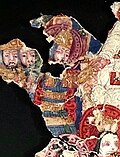Uyghur people
The Uyghurs (wee-ger; 维吾尔人) are a Turkic people and a Central Asian ethnic group, living mainly in Xinjiang, nowadays a province located in the far northwest of China. Over 11 million Uyghurs live there, far more than any other part of the world.
 Uyghur man at the Sunday market in Kashgar | |
| Regions with significant populations | |
|---|---|
(Xinjiang) | 11,303,355[1] |
| 223,100 (2009)[2] | |
| 55,220 (2008) | |
| 49,000 (2009)[3] | |
| 45,800 (2010)[4][5] | |
| ~50,000 (2013) (Saudi Labor Ministry)[6] | |
| ~3,500 (2015) (Uyghur Turkistan Islamic Party members plus families in Zanbaqi (الزنبقي) in Jisr al-Shughur)[7][8][9][10] | |
(Uyghurs in Pakistan) | ~1,000 families (2010)[11] |
| 3,696 (2010)[12] | |
| 197 (2001)[13] | |
| Languages | |
| Uyghur | |
| Religion | |
| Sunni Islam (Hanafi) | |
| Related ethnic groups | |
| other Turkic peoples | |
| This article contains Uyghur text. Without the correct software, you may see unjoined letters or other symbols instead of Uyghur script. |
Many Uyghurs also live in Beijing, Shanghai[14] and Taoyuan County (Hunan, South-Central China).[15] There are Uyghur diasporic communities in Turkey, Kazakhstan, Kyrgyzstan, Uzbekistan, Pakistan and Mongolia. However, the vast majority of Uyghurs live in their native homeland Xinjiang.
Uyghurs are mainly Sunni Muslim and speak Uyghur, a Turkic language. The Uyghur alphabet is based on the Arabic alphabet. The vast majority of Uyghurs follow the Hanafi school of Sunni Islam.
Most Uyghurs were originally from the ancient Karluk tribes of the Kara-Khanid Khanate and immigrated to what is now Xinjiang during the 8th or 9th centuries AD. Modern Uyghurs identify with the Karakhanids even though the name Uyghur was taken from the Manichaean Uyghur Khaganate and the Buddhist state of Qocho.[16][17]
At a conference in Tashkent in 1921, representatives of the New Uyghur-speaking population of West Turkestan, whose language does not go back directly to the Old Uyghur of Mongolia, or only to a small extent, adopted the name "Uyghurs" for themselves.[18][19]
Some Uyghurs seek independence from China.[20]
- REDIRECT Template:See also
Uyghur People Media
A Uyghur girde naan baker
Mural fragment depicting two Uyghur donors, from the Bezeklik Thousand Buddha Caves. Kept in the Museum of Asian Art in Berlin.
Uyghur princes from Cave 9 of the Bezeklik Thousand Buddha Caves, Xinjiang, China, 8th–9th century AD, wall painting
Bögü Qaghan, the third Khagan of the Uyghur Khaganate, in a suit of armor; 8th century Manichean manuscript (MIK III 4979)
Chagatai Khanate (Moghulistan) in 1490
References
- ↑ "Statistical Yearbook of Xinjiang in 2016". Xinjiang Uygur Autonomous Region Statistics Bureau. Archived from the original on 11 October 2017.
- ↑ Агентство Республики Каписью на 26,1% и составила 10098,6 тыс. человек. Увеличилась численность узбеков на 23,3%, составив 457,2 тыс. человек, уйгур — на 6%, составив 223,1 тыс. человек. Снизилась численность русских на 15,3%, составив 3797,0 тыс. человек; немцев — на 49,6%, составив 178,2 тыс. человек; украинцев – на 39,1%, составив 333,2 тыс. человек; татар – на 18,4%, составив 203,3 тыс. человек; других этносов – на 5,8%, составив 714,2 тыс. человек.
- ↑ Национальный статистический комитет Кыргызской Республики : Перепись населения и жилищного фонда Кыргызской Республики 2009 года в цифрах и фактах — Архив Публикаций — КНИГА II (часть I в таблицах) : 3.1. Численность постоянного населения по национальностям Archived 2012-03-08 at the Wayback Machine
- ↑ Yitzhak Shichor; East-West Center (2009). Ethno-diplomacy, the Uyghur hitch in Sino-Turkish relations. East-West Center. p. 16. ISBN 978-1-932728-80-4.
- ↑ Uygur Ajan Rabia Kadir, Doğu Türkistanlı Mücahidleri İhbar Etti. 8 January 2015. http://www.islahhaber.net/uygur-ajan-rabia-kadir--dogu-turkistanli-mucahidleri-ihbar-etti-42554.html.
- ↑ "Nitaqat rules for Palestinians and Turkistanis eased". arabnews.com. Sadui Labor Ministry. Retrieved 3 November 2015.
- ↑ ابنا, الميادين + (September 3, 2015). "قرية الزنبقي السورية أقرب إلى الصين منها الى دمشق + صور". ar.abna24.com.
- ↑ "داعش جلب آلاف المقاتلين مع عائلاتهم إلى الرقة" – via YouTube.
- ↑ الحربي, كتائب الإعلام. "كتائب الإعلام الحربي". harbipress.com. Archived from the original on 2017-12-13. Retrieved 2017-11-20.
- ↑ "بالفيديو : قرية الزنبقي يتحول الى مستوطنة للأيغور والتركمان". Archived from the original on 2015-09-25. Retrieved 2017-11-20.
- ↑ Hoshur, Shohret; Shemshidin, Zubeyra (2010-04-06), "Pakistan Uyghurs in Hiding: Brothers blame raids and arrests on pressure from China", Radio Free Asia, retrieved 2010-05-11
- ↑ "Перепись населения России 2010 года". Archived from the original on 2021-12-23. Retrieved 2014-03-03.
- ↑ State statistics committee of Ukraine - National composition of population, 2001 census (Ukrainian)
- ↑ "Chinese Cultural Studies: Ethnography of China". Archived from the original on 2016-03-25. Retrieved 2008-02-22.
- ↑ "Ethnic Uygurs in Hunan Live in Harmony with Han Chinese". en.people.cn.
- ↑ Barfield, Thomas (2008). "Review of Eurasian Crossroads: A History of Xinjiang". China Review International. 15 (2): 52–56. ISSN 1069-5834. JSTOR 23733145. Retrieved 13 July 2022.
- ↑ Starr, S. Frederick (31 March 2004). Xinjiang : China's Muslim borderland (1 ed.). Armonk, N.Y.: M.E. Sharpe Inc. p. 42. ISBN 978-0-765-61318-9. Retrieved 13 July 2022.
- ↑ Meyer-Ingwersen, Johannes (2016). Glück, Helmut; Rödel, Michael (eds.). Metzler Lexikon Sprache (in Deutsch) (5., aktualisierte und überarbeitete Auflage ed.). Stuttgart: Metzler, J.B. p. 732. doi:10.1007/978-3-476-05486-9. ISBN 978-3-476-02641-5. Retrieved 13 July 2022.
- ↑ Weekes, Richard V. (1984). Muslim peoples : a world ethnographic survey (2nd, rev. and expanded ed.). Westport, Conn.: Greenwood Press. pp. 830–833. ISBN 0-313-24640-8. Retrieved 13 July 2022.[dead link]
- ↑ "U.N. says it has credible reports that China holds million Uighurs in secret camps" (in en). Reuters. 2018-08-12. https://www.reuters.com/article/us-china-rights-un-idUSKBN1KV1SU. Retrieved 2020-07-31.
Related pages
| Wikimedia Commons has media related to Lua error in Module:Commons_link at line 62: attempt to index field 'wikibase' (a nil value).. |








